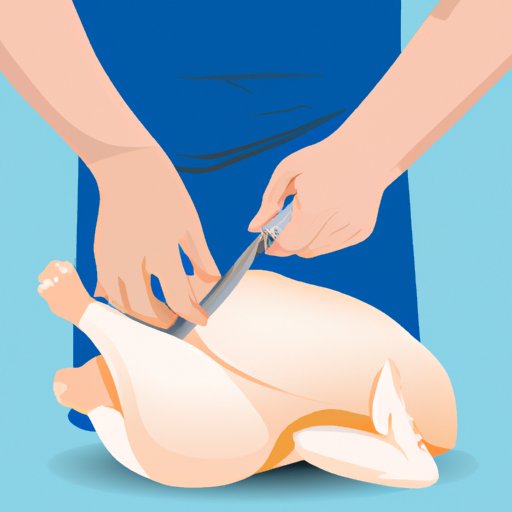
I. Introduction
Cutting a whole chicken may seem daunting, but it is a practical skill to have if you enjoy cooking and want to save money. Knowing how to cut a whole chicken allows you to buy in bulk and customize your cuts for different recipes. Plus, using the whole chicken reduces waste and increases nutritional value.
II. Necessary Tools and Ingredients for Cutting a Whole Chicken
To cut a whole chicken safely and efficiently, you will need the following tools:
- Cutting board
- Sharp knife
- Kitchen shears
- Paper towels
- Large plate or tray
You will also need a whole chicken and any additional ingredients for your recipe. Before you begin cutting, it is important to practice safety measures such as washing your hands and sanitizing your tools and workspace.
To cut a whole chicken, follow these step-by-step instructions:
- Remove the giblets and neck from the cavity of the chicken.
- Pat the chicken dry with paper towels.
- Place the chicken breast-side up on a cutting board.
- Locate the joint between the thigh and the body of the chicken.
- Cut through the joint to remove the leg and thigh from the body.
- Repeat on the other side.
- Locate the joint between the wing and the body of the chicken.
- Cut through the joint to remove the wings from the body.
- With the breast facing up, make a cut down the center of the chicken’s breastbone.
- Open the chicken up like a book by gently pressing on the breastbone.
- Take a sharp knife and cut through the cartilage and ribs to separate the breast from the backbone.
- Repeat on the other side to get two breast halves.
III. Benefits of Preparing a Whole Chicken
Preparing a whole chicken offers many benefits:
- Cost-effectiveness: Buying a whole chicken is cheaper than buying individual pieces.
- Versatility: A whole chicken can be used for multiple dishes and meals.
- Nutrition: Cooking with the whole chicken, including bones and skin, adds flavor and nutrition.
To maximize the benefits of preparing a whole chicken, here are some tips for storing and using different parts of the chicken:
- Store the chicken in the refrigerator or freezer.
- Use the giblets and neck for making chicken stock or gravy.
- Use the wings for chicken stock or buffalo wings.
- Use the legs and thighs for fried chicken, barbecue, or soups.
- Use the breast for roasting, grilling, or salads.

IV. Breaking Down a Whole Chicken
A whole chicken can be broken down into several cuts, each with their own uses:
- Whole chicken
- Breast halves
- Wings
- Leg quarters (thigh and drumstick)
- Backbone and giblets (for stock or gravy)
To break down a whole chicken, follow these instructions:
- Remove the wings and set aside.
- Remove the legs by cutting through the joint between the thigh and drumstick.
- Remove the backbone by cutting through the ribs on either side.
- Make a horizontal cut through the breastbone, separating the breast into two halves.
- Use a knife to separate the leg from the thigh.
- Cut the wing at the joint between the drumette and flat, creating two pieces.
V. Adaptability of Different Chicken Cuts for Cooking
Each chicken cut requires a different cooking method and preparation:
- Whole chicken: Roasting, grilling, or rotisserie
- Breast halves: Grilling, baking, or pan-searing
- Wings: Baking, frying, or grilling
- Leg quarters: Braising, roasting, or grilling
To properly prepare each cut for optimal results, follow these tips:
- Season the chicken with your desired spices.
- Allow the chicken to come to room temperature before cooking.
- Pat the chicken dry before cooking to ensure crispy skin.
- Use a meat thermometer to check for doneness.
VI. Recipes for Various Whole Chicken Cuts
Here are some recipes showcasing the versatility of different chicken cuts:
- Whole chicken: Rotisserie chicken, lemon herb roasted chicken
- Breast halves: Grilled chicken breasts, crispy chicken tenders
- Wings: Buffalo wings, honey mustard wings
- Leg quarters: Braised chicken with tomatoes, barbecued chicken thighs
Before preparing each cut, make sure to properly de-bone and trim the chicken to your desired shape and size.
VII. Nutritional Benefits and Dietary Restrictions of Chicken
Chicken offers many nutritional benefits:
- High in protein
- Low in fat
- Rich in vitamins and minerals
When preparing a whole chicken, it is important to consider any dietary restrictions or allergies. Some people may need to avoid certain parts of the chicken, such as the skin or dark meat, depending on their dietary needs.
VIII. Conclusion
Cutting a whole chicken allows you to save money, increase nutrition, and customize your cuts for different recipes. Using the whole chicken reduces waste and offers a variety of cooking options. By following these tips and recipes, you can prepare a delicious and nutritious meal with ease.





